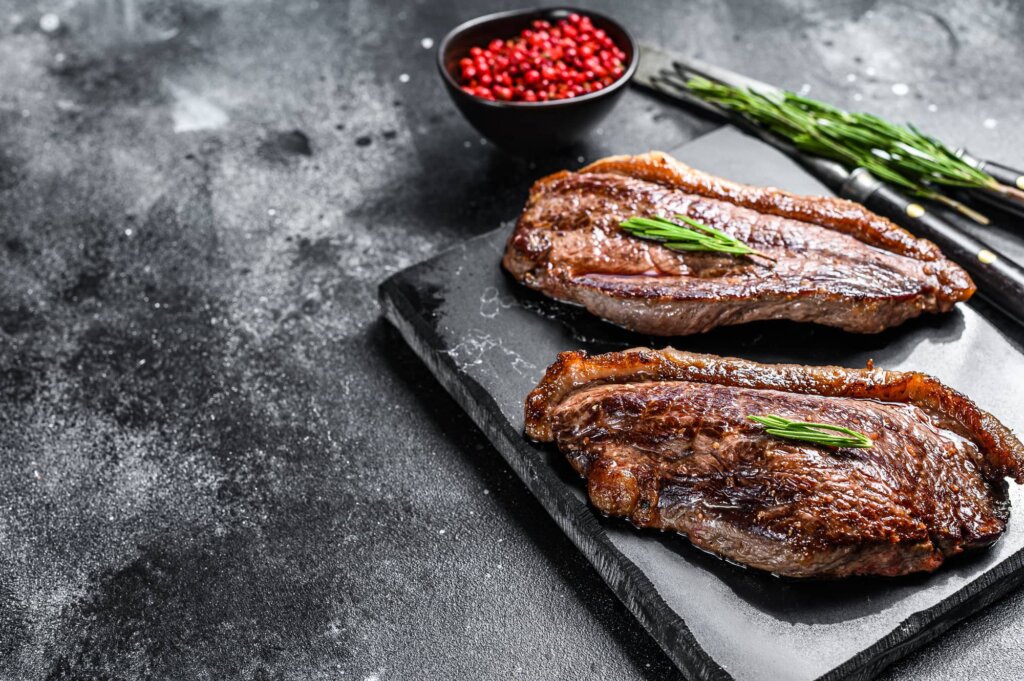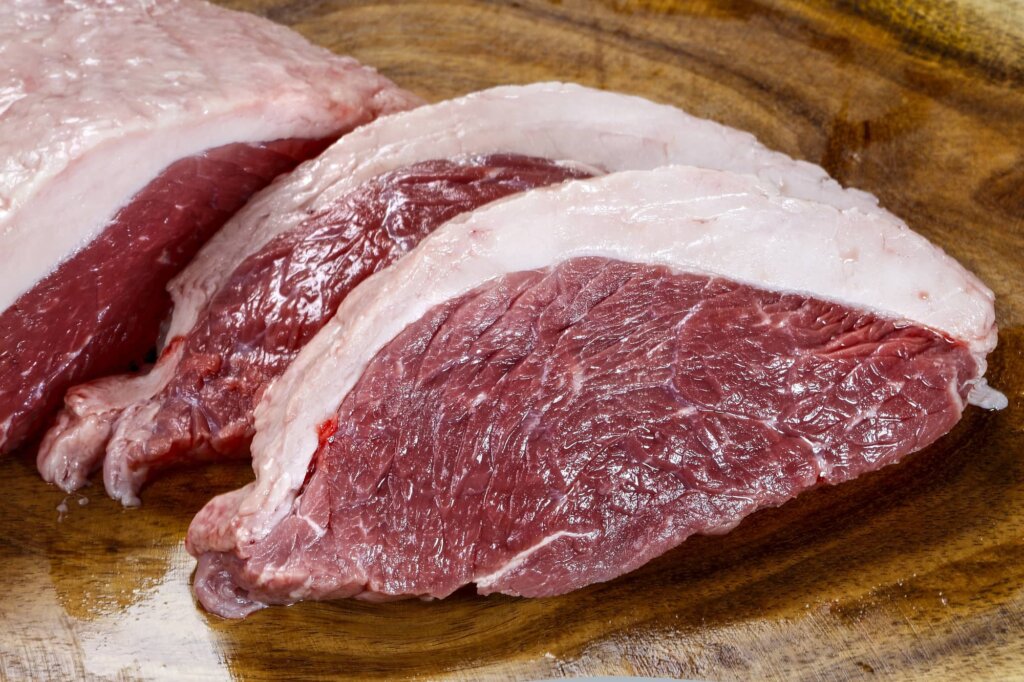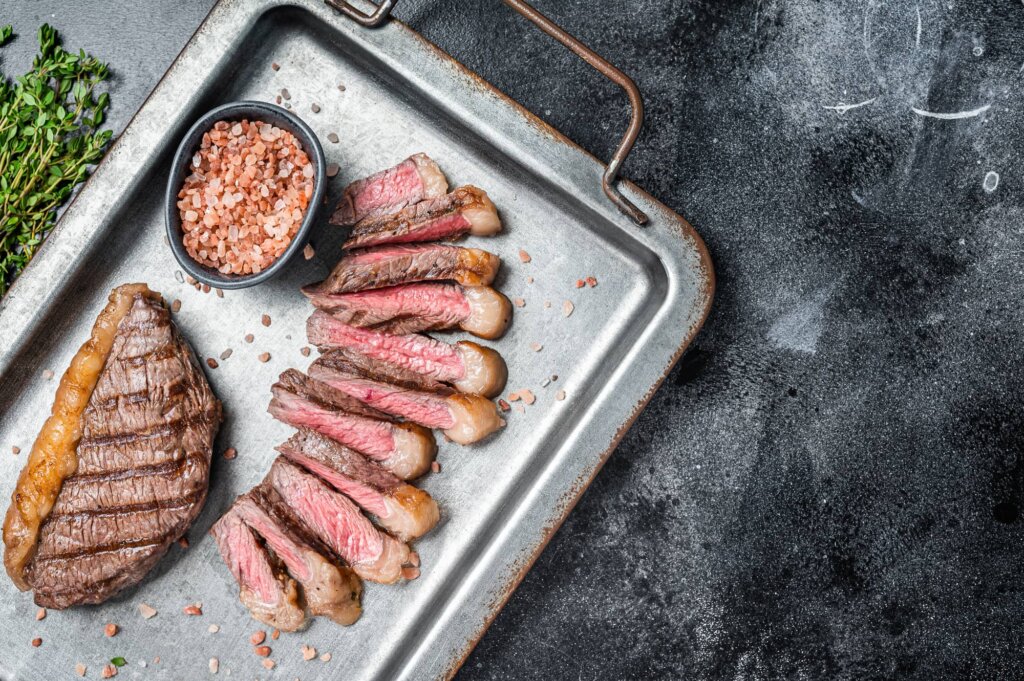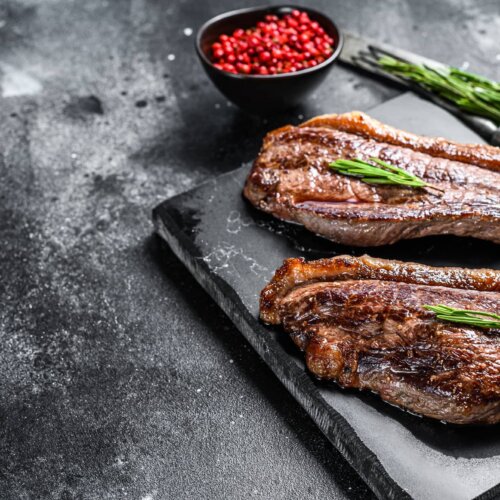
Learning to reverse sear picanha steak can be one of the best things you can do to enhance your collection of meal ideas. While reverse searing can work well with several cuts of steak, it’s an especially helpful cooking method for picanha steak, which has a tell-tale fat cap that needs some extra time to cook down and do everything it’s supposed to do to add flavor and juiciness to picanha.
Continue with this guide to learn what reverse searing is, why you should try it with picanha steak, and how to do it correctly.
Why Reverse Searing?
Reverse searing flips the traditional approach to cooking steak (sear, then finish cooking) by starting with a low, gentle heat before finishing with a quick, high-heat sear. This method is best for thicker cuts that tend to overcook on the outside while waiting for the middle to catch up. As the steak warms through slowly, it holds in moisture and tenderness, making dialing in on the perfect doneness easier. Once the meat nears your target temperature, you cook it over high heat to create a rich, crispy exterior.
Picanha, known for its thick fat cap and strong beef flavor, really shines when reverse seared. The slower initial cooking phase with low heat gives the fat layer time to render down and infuse the meat with savory richness while keeping it moist. The final sear crisps up that cap and the rest of the steak, adding a satisfying bite to contrast the tender, evenly cooked center. If you want to coax the best out of picanha’s unique qualities, reverse searing is a must-try cooking method.
Choosing the Right Cut
When you’re on the hunt for top-quality picanha, the first thing to note is the cut’s signature shape. It’s triangular because it’s cut from the top portion of a cow’s rump. That’s also why it has a prominent layer of fat attached to it, also known as a fat cap. Ideally, you’ll want to see a thick, uniform fat cap that isn’t mottled or discolored. This is one cut where you don’t want to be afraid of having too much fat, as it’s a big contributor to the steak’s flavor. Fine marbling, or streaks of fat, running through the meat are perfectly okay too, as the fat will render down during cooking to enhance juiciness and flavor. As for the meat itself, look for a bright, cherry-red color.
A good picanha should also have a decent thickness, usually around two to three inches at the thickest point. If it’s too thin, you may have trouble reverse searing without overcooking. If needed, ask your butcher some questions, like where they source the meat, how it’s graded, and how fresh it is. Quality makes a big difference with picanha, so it’s important to know that you’re getting what you pay for.

Preparing the Picanha
Preparation is a key part of cooking steak, including picanha. A well-prepared picanha has a better chance of turning out the way you want when you cook it. First, look at the fat cap. While you want to leave most of it intact, it might help to trim away particularly thick or large pieces of fat that won’t have enough time to render down. This leaves the highest quality fat in place to work its magic during the reverse sear process.
Next, pat the steak dry with paper towels so the surface isn’t damp, which can prevent browning. Leave the steak at room temperature for 30 minutes before you begin the cooking process. This helps the internal temperature rise slightly to be more aligned with the outside temperature, which will allow it to cook more evenly later.
Then, decide how you want to season your steak. Some cooks stick with just salt and pepper for simplicity, letting the natural beefiness of picanha shine through. But you can also add garlic powder, paprika, or your favorite steak seasoning mix. Feel free to experiment here to come up with your own flavors.
Reverse Searing Process
You’ll start with low, steady heat to reverse sear picanha steak. Think of it like warming the steak from the inside out, allowing it to gently rise to just below your target doneness. You can do this in an oven set to around 225°F or on a grill with indirect heat, but we’ll explain how to do it using an oven. Place the picanha on a rack or in a low-sided pan, ensuring warm air circulates evenly around it. Because of the low temperature, the steak won’t cook past the target sweet spot, giving you more control over the final outcome. This first cook can take anywhere from 30 minutes to an hour, depending on the thickness of your cut.
Once the internal temperature is a few degrees shy of your goal — typically around 5-10°F below — pull the picanha from the oven and let it rest briefly. Heat a cast-iron skillet or a skillet that can withstand high heat, adding a drizzle of oil to it. Carefully place the picanha in the pan to sear for 1-2 minutes on each side, just until a golden-brown, crispy crust forms. Use tongs to hold the steak on its sides to crisp them, too. Then, rest the steak at room temperature for 5-10 minutes. It’ll continue rising in temperature during this resting period to help it reach its final doneness temperature (130–135°F for medium-rare).
Tips for Making the Best Reverse Seared Picanha Steak
Make your reverse seared picanha steak stand out with these expert tips:
- Rotate for Even Cooking: Picanha may not be a uniform thickness, which can make some parts cook faster than others. If your picanha is uneven in some parts, rotate it in the oven at least once during the low-heat stage so all sides get an even amount of heat.
- Use a Remote Probe Thermometer: Constantly opening the oven or grill can disrupt your cooking environment. Inserting an oven-safe probe into the thickest portion of the meat and monitoring the temperature gives you a clear picture of its progress without losing heat. Plus, you’ll see immediately if things are moving faster or slower than expected, letting you adjust accordingly.
- Place a Drip Tray Underneath: While we love the fat cap on picanha for adding depth and flavor to the meat, cooking fat can lead to greasy drips in the oven. Be sure to cook picanha on a rack inside of a pan with sides to catch drippings. Reuse the drippings for basting or to make a quick gravy afterward.
Reverse Seared Picanha Steak Recipe

Try your hand at reverse searing picanha steak using the following recipe.
Ingredients
- 1 picanha steak (about 2–3 pounds)
- 2 teaspoons coarse salt
- 1 teaspoon freshly ground black pepper
- 1 teaspoon smoked paprika
- 1 tablespoon olive oil
- 2 cloves garlic, finely minced
- 2 sprigs fresh rosemary or thyme (optional)
- Olive oil, for searing
Instructions
- Take the picanha out of the fridge about 30 minutes before cooking. Pat it dry and score the fat cap with a few shallow cuts, being careful not to cut into the meat.
- In a small bowl, mix salt, pepper, smoked paprika, and minced garlic. Rub the steak with olive oil and press the seasoning mixture onto all sides. Tuck a sprig of rosemary or thyme under the fat cap if you’d like for some extra aromatics.
- Preheat your oven to 225°F. Place the steak on a wire rack set over a baking sheet, fat side up. Slide it into the oven, allowing the heat to gently raise the meat’s internal temperature. Depending on thickness, this can take 30–60 minutes. Aim for about 115°F for medium-rare.
- Remove the steak from the oven once it hits 10-15°F lower than your final target temperature. Heat a heavy skillet over high heat with a drizzle of oil. Sear the picanha for about 1-2 minutes per side to form a crust, turning carefully with tongs.
- Let the steak rest for 5 minutes under a loose tent of foil at room temperature. Slice against the grain before serving.
Recipe Variations
You can easily make this recipe more personalized to your tastes by changing the spices you use for different flavors.
For example, try marinating the picanha in a marinade of orange juice, lemon zest, and a dash of soy sauce. Add minced garlic and a bit of honey for sweetness, letting the meat soak up those flavors for at least an hour before you begin the reverse sear. This adds a fun citrusy kick to the meat. Or, if you want some spicy additions, season the steak generously with a Southwestern-style rub. Combine chili powder, ground cumin, a hint of cinnamon, and cayenne pepper. Pat the rub on just before placing the picanha in the oven, then finish with an extra dusting of chili powder before you sear for a little more heat.
Conclusion: How to Reverse Sear Picanha Steak
Reverse searing is one of the best methods you can use for picanha steak. It gives this steak enough time to melt down some of its fat content for extra flavor and juiciness while still creating that sear most steak enthusiasts want. Remember that you can also use this method on the grill rather than the oven if you’d prefer.
When you’re ready to learn how to cook picanha steak using other cooking methods, visit Steak University. We have tips on grilling picanha steak, smoking picanha steak, and more.

Reverse Seared Picanha Steak
Ingredients
- 1 picanha steak about 2–3 pounds
- 2 teaspoons coarse salt
- 1 teaspoon freshly ground black pepper
- 1 teaspoon smoked paprika
- 1 tablespoon olive oil
- 2 cloves garlic finely minced
- 2 sprigs fresh rosemary or thyme optional
- Olive oil for searing
Instructions
- Take the picanha out of the fridge about 30 minutes before cooking. Pat it dry and score the fat cap with a few shallow cuts, being careful not to cut into the meat.
- In a small bowl, mix salt, pepper, smoked paprika, and minced garlic. Rub the steak with olive oil and press the seasoning mixture onto all sides. Tuck a sprig of rosemary or thyme under the fat cap if you’d like for some extra aromatics.
- Preheat your oven to 225°F. Place the steak on a wire rack set over a baking sheet, fat side up. Slide it into the oven, allowing the heat to gently raise the meat’s internal temperature. Depending on thickness, this can take 30–60 minutes. Aim for about 115°F for medium-rare.
- Remove the steak from the oven once it hits 10-15°F lower than your final target temperature. Heat a heavy skillet over high heat with a drizzle of oil. Sear the picanha for about 1-2 minutes per side to form a crust, turning carefully with tongs.
- Let the steak rest for 5 minutes under a loose tent of foil at room temperature. Slice against the grain before serving.

